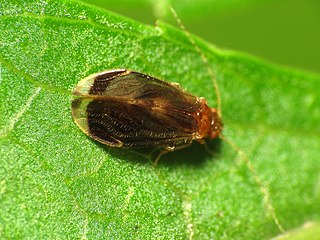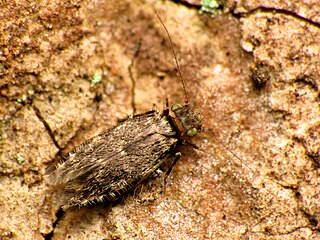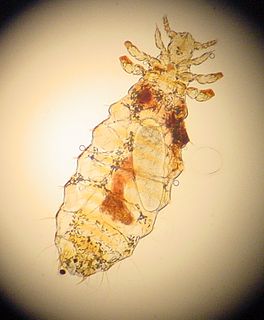
Psocomorpha is a suborder of barklice, booklice, and parasitic lice in the order Psocodea. There are more than 20 families and 5,300 described species in Psocomorpha.

Trogiomorpha is one of the three major suborders of barklice, booklice, and parasitic lice in the order Psocodea, alongside Troctomorpha and Psocomorpha. There are about 8 families and more than 430 described species in Trogiomorpha. Trogiomorpha is widely agreed to be earliest diverging of the three suborders, and retains the most primitive characteristics.

Caeciliusetae is an infraorder of Psocodea in the suborder Psocomorpha. There are about 6 families and more than 1,300 described species in Caeciliusetae.

Caeciliusidae is a family of Psocodea belonging to the suborder Psocomorpha. The family was once named Caeciliidae, but the latter name was changed because of homonymy with the amphibian family Caeciliidae. The subfamily Paracaeciliinae was formerly in Caeciliusidae, but it has been elevated to family rank, Paracaeciliidae.

Lepidopsocidae are an insect family of bark lice belonging to the suborder Trogiomorpha. Colloquially, Lepidopsocidae are referred to as the Scaly-winged Barklice. There are more than 220 species described worldwide. Phylogenetic DNA analysis of relationships between families in Trogiomorpha propose that Lepidopsocidae is monophyletic, meaning that the taxa within all share a common ancestor. This is supported morphologically by the presence of scales and setae covering the body and forewings of Lepodopsocids. Sister families of Lepidoposcidae include Trogiidae and Psoquillidae.

Psyllipsocidae is a family of cave barklice in the order Psocodea. There are about 7 genera and more than 70 described species in Psyllipsocidae.
Rhyopsocus is a genus of bird nest barklice in the family Psoquillidae. There are more than 20 described species in Rhyopsocus.

Trogiidae is a family of granary booklice in the order Psocodea. There are about 11 genera and more than 50 described species in Trogiidae.
Steleops is a genus of common barklice in the family Psocidae. There are more than 20 described species in Steleops.

Polypsocus is a genus of hairy-winged barklice in the family Amphipsocidae. There are more than 20 described species in Polypsocus.
Rhyopsocus eclipticus is a species of bird nest barklouse in the family Psoquillidae. It is found in North America and Europe.
Lithoseopsis is a genus of tropical barklice in the family Amphientomidae. There are about 10 described species in Lithoseopsis.
Enderleinellidae is a family of parasitic lice in the order Psocodea. There are about 5 genera and more than 50 described species in Enderleinellidae.

Hoplopleuridae is a family of lice in the order Psocodea. There are about 6 genera and more than 150 described species in Hoplopleuridae.

Linognathidae is a family of lice in the order Psocodea. There are at least 3 genera and 70 described species in Linognathidae.

Paracaeciliidae is a family of bark lice in the order Psocodea. There are about 5 genera and more than 100 described species in Paracaeciliidae.
Protroctopsocidae is a family of psocids in the order Psocodea. There are at least four genera and about five described species in Protroctopsocidae.
Trimenoponidae is a family of lice in the order Psocodea. There are about 6 genera and 18 described species in Trimenoponidae.

Nanopsocetae is one of two major divisions of Troctomorpha in the Psocoptera, alongside Amphientometae. There are more than 20 families and 5,200 described species in Nanopsocetae.

Amphientometae is an infraorder of psocids in the order Psocoptera. There are about 7 families and at least 230 described species in Amphientometae.









